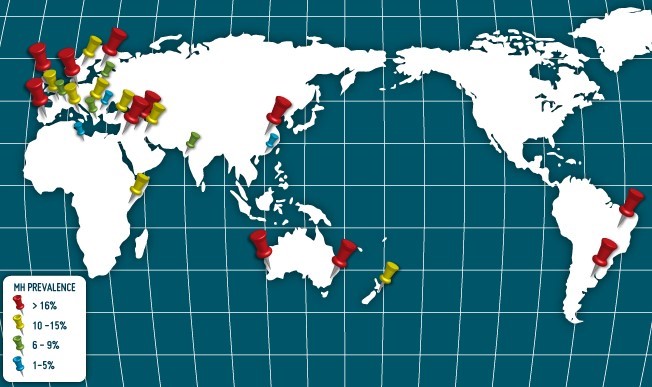Teeth enamel problems (MIH) 11 percent less likely with just 4 ng more vitamin D
Elevated Serum 25(OH)-Vitamin D Levels Are Negatively Correlated with Molar-Incisor Hypomineralization.
J Dent Res. 2014 Dec 10. pii: 0022034514561657. [Epub ahead of print]
Kühnisch J1, Thiering E2, Kratzsch J3, Heinrich-Weltzien R4, Hickel R5, Heinrich J6; for the GINIplus study group; the LISAplus study group; for the GINIplus study group. Collaborators (49)
1Department of Conservative Dentistry and Periodontology, School of Dentistry, Ludwig-Maximilians-University of Munich, Munich, Germany jkuehn@dent.med.uni-muenchen.de.
2Institute of Epidemiology I, Helmholtz Zentrum Munich, German Research Centre for Environmental Health, Neuherberg, Germany Dr. von Hauner Children's Hospital, Ludwig-Maximilians-University Munich, Munich, Germany.
3Institute of Laboratory Medicine, Clinical Chemistry and Molecular Diagnostics, University Hospital Leipzig, Leipzig, Germany.
4Department of Preventive and Paediatric Dentistry, Friedrich-Schiller-University of Jena, Jena, Germany.
5Department of Conservative Dentistry and Periodontology, School of Dentistry, Ludwig-Maximilians-University of Munich, Munich, Germany.
6Institute of Epidemiology I, Helmholtz Zentrum Munich, German Research Centre for Environmental Health, Neuherberg, Germany
To date, the precise etiology of molar-incisor hypomineralization (MIH) is uncertain. Vitamin D plays a key role in hard tissue formation. Therefore, this study aimed to analyze the relationship between serum 25-hydroxy-vitamin D (25(OH)D) status and dental health data obtained from 1,048 children in a 10-year follow-up of the Munich GINIplus and LISAplus birth cohorts. The dental examination included the diagnosis of MIH and recording of (non-)cavitated caries lesions in primary and permanent teeth. Serum 25(OH)D concentrations were taken from blood samples of the 10-year investigation and measured with a fully automated, modular system. Different logistic regression and Poisson hurdle models were calculated. MIH was diagnosed in 13.6% of the study population. Approximately 16.4% of the children demonstrated caries-related defects (D3-4MFS > 0). The mean season-adjusted concentration of 25(OH)D was 75.8 nmol/l (standard deviation 22.0 nmol/l).
After adjusting for sex, age, body mass index, parental education, equivalent income, and television/personal computer (TV/PC) viewing hours, a 10 nmol/l increase in serum 25(OH)D concentrations was significantly associated with a lower odds ratio of having MIH ( OR = 0.89 ; P = 0.006). Furthermore, higher 25(OH)D values were associated with a lower number of caries-affected permanent teeth. It is concluded that elevated serum 25(OH)D concentrations were associated with better dental health parameters.
PMID: 25503610
Map of MH problems around the world

Notice: Except for Brazil (40%!), the problems are not near the equator
See also VitaminDWiki
Tooth loss reduction by 15 percent associated with 10 ng higher vitamin D – May 2014
Dental health improved with more than 800 IU of vitamin D – June 2013
UVB added in classroom reduced cavities, increased height, increased academics. etc
Review of Dental Caries at Vitamin D Council (Sept 2014) includes the following
Taking vitamin D supplements resulted in a 47% reduced rate of dental caries.
Taking vitamin D supplements had no effect on caries in those older than 13 years old, especially in girls.
Dental caries are more common in late winter and early spring, which is when vitamin D levels tend to be lower.
Children with severe ECC have lower vitamin D levels compared to children without caries.
Mothers with low vitamin D levels are more likely to give birth to children who develop dental caries.
Vitamin D supplementation may help reduce the risk of developing dental caries.
